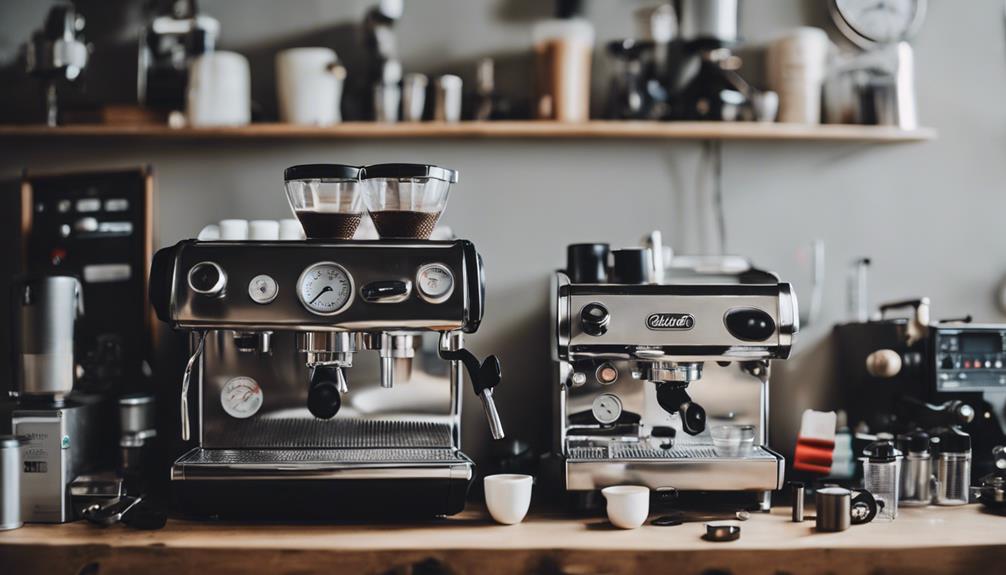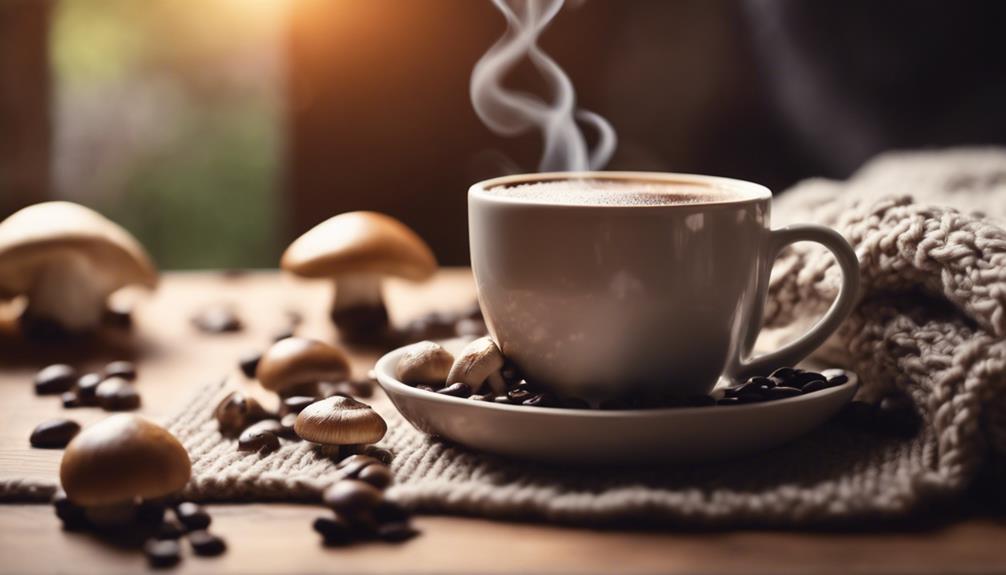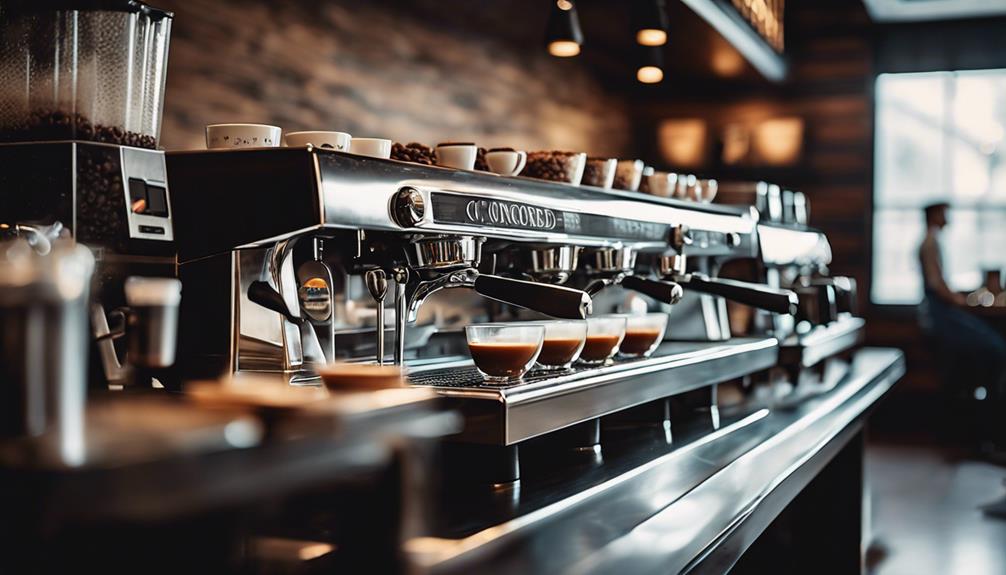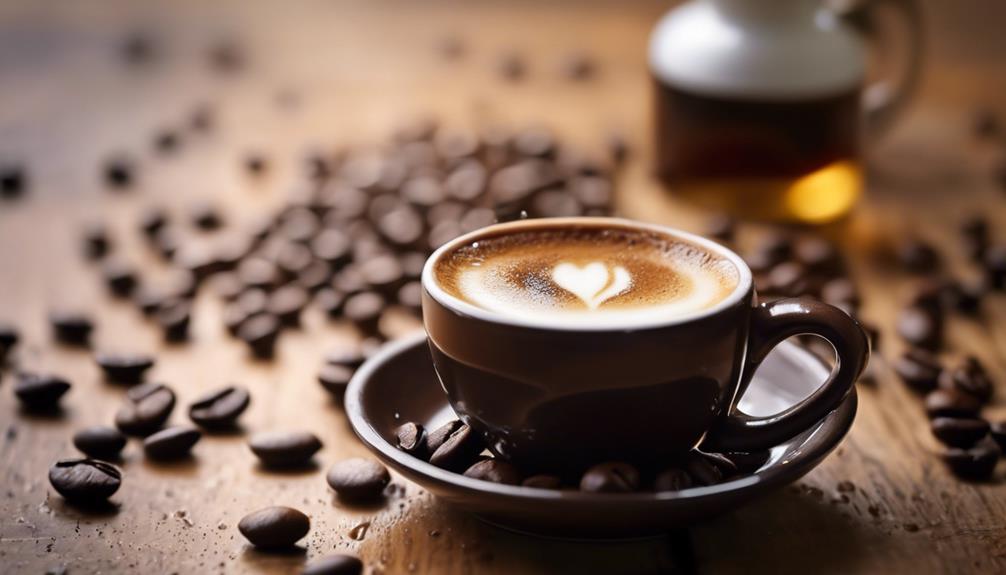You depend on multiple crucial components to ensure that your espresso machine operates efficiently, and neglecting to maintain or replace them could result in mediocre brews and expensive repairs. The boiler, group head, portafilter, steam wand, and drip tray in your machine all have crucial roles in producing the perfect espresso shots. Regular upkeep, which includes daily cleaning and scheduled part replacements, is essential in preventing problems and guaranteeing optimal performance. By comprehending the functions of each part and learning how to properly care for them, you will be well-equipped to brew like a professional – and there is still more to discover about keeping your machine in top condition.
Key Takeaways
- Regularly replace essential parts like group gaskets and shower screens to maintain optimal performance and prevent issues.
- Use high-quality OEM parts to ensure compatibility and reduce repairs, prioritizing maintenance to prevent minor issues from escalating.
- Daily backflushing removes coffee oils and grounds, while scheduled maintenance checks group flow rates and temperature consistency.
- The portafilter requires regular cleaning and inspection for cracks to ensure brew quality, and the steam wand needs maintenance to avoid milk residue buildup.
Understanding Espresso Machine Components
You'll find five key components working together in harmony to produce the perfect shot of espresso: the boiler, group head, portafilter, steam wand, and drip tray.
These components are the backbone of your espresso machine, and understanding their roles is critical for peak performance.
The boiler is the powerhouse behind your espresso, generating the necessary heat and pressure to brew your coffee.
The group head is the central hub where the magic happens, regulating water flow and pressure to extract the perfect shot.
The portafilter is where you'll add your coffee grounds, and it's important to clean it regularly to guarantee consistent extraction quality.
Meanwhile, the steam wand is responsible for frothing milk to perfection, but it requires regular maintenance to prevent milk residue buildup.
Finally, the drip tray collects excess coffee and water, and it's imperative to clean it frequently to maintain hygiene and prevent coffee oil accumulation.
Essential Parts for Optimal Performance
As you work to optimize your espresso machine's performance, you'll want to focus on the essential parts that make all the difference.
You're probably aware that regular maintenance is key, but which components should you prioritize?
Let's take a closer look at the vital elements, from group head maintenance to portafilter cleaning tips, to guarantee you're pulling perfect shots every time.
Essential Espresso Components
Maintaining peak performance in your espresso machine relies on several essential components working in harmony, with each playing a critical role in delivering a perfect shot.
Among these critical Espresso Machine Parts, the group head stands out as the central component for espresso brewing, responsible for flavor extraction.
You'll need to inspect your portafilters regularly for cracks and guarantee they fit properly to maintain brew quality.
The group gaskets, large rubber O-rings that seal the portafilter to the group head, should be replaced quarterly to prevent leaks and maintain consistent pressure.
Additionally, the group screens, or dispersion screens, guarantee even water distribution over coffee grounds and should be cleaned regularly to avoid clogs and replaced every three months for consistent extraction.
Don't forget about the steam wand, essential for frothing milk, which requires regular cleaning to eliminate milk residue buildup and maintain ideal steaming performance.
Group Head Maintenance
With your portafilters and group gaskets in check, it's time to focus on the group head, the heart of your espresso machine, where regular maintenance can make all the difference in peak performance.
As the central component responsible for regulating water flow and pressure through the portafilter, the group head requires attention to guarantee consistent extraction quality.
To maintain peak performance, you'll want to:
- Clean the group screen to prevent clogs and guarantee even water distribution.
- Backflush the group head at the end of each day to remove coffee oils and debris.
- Inspect and replace portafilter baskets as needed to guarantee proper fit and function.
Portafilter Cleaning Tips
How often do you clean your portafilter, and are you doing it correctly to prevent buildup and assure peak espresso quality? Regular cleaning is essential to maintain ideal performance and prevent coffee oils from building up, which can affect flavor and extraction quality.
After each use, inspect the portafilter basket for clogs or dents, as signs of wear can impact pressure and result in uneven extraction.
During backflushing, use a blind filter and espresso machine detergent to effectively clean the portafilter and group head. Confirm the portafilter filter spring is securely holding the basket in place to maintain stability during brewing and prevent leaks.
If you notice any issues, don't hesitate to replace the portafilter or its components, such as the filter basket and spring, as needed. This will assure ideal performance and consistent espresso quality.
Maintenance and Replacement Schedules
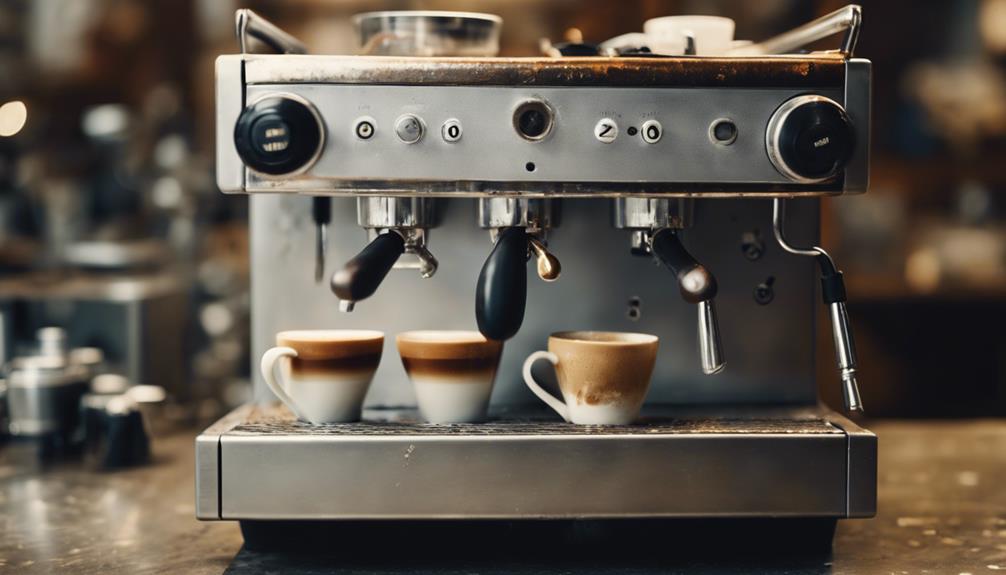
To keep your espresso machine in top shape, you'll need to establish a routine of essential maintenance tasks, daily cleaning routines, and scheduled replacement plans.
By doing so, you'll prevent issues like coffee oil buildup, leaks, and inconsistent extraction quality.
Essential Maintenance Tasks
Regularly incorporating essential maintenance tasks into your espresso machine's routine guarantees peak performance and prevents costly repairs down the line. By doing so, you'll make certain your machine is running smoothly and efficiently, preserving its functionality and extending its lifespan.
To maintain your espresso machine's best performance, you should conduct the following tasks at regular intervals:
- Minor service tasks: Every three months, replace group gaskets and upgrade shower screens to maintain pressure and extraction consistency.
- Major service: Every six months, rebuild the steam assembly and water tap, and clean the boiler level probe to prolong machine life.
- Comprehensive annual service: Replace the pressure safety valve and upgrade portafilter baskets to improve extraction quality.
Additionally, monitor and replace specific lifetime items, such as water filters and pumps, as needed to prevent equipment failures.
Daily Cleaning Routines
As you wrap up each espresso-making session, incorporating daily cleaning routines into your workflow guarantees your machine remains in peak condition, preventing the buildup of coffee oils and debris that can compromise flavor and machine longevity.
To start, backflush your espresso machine to remove any coffee oils and grounds that may have accumulated. This daily maintenance task secures consistent flavor extraction and machine performance.
Next, grab your machine brush and clean the group head after each use to prevent the buildup of coffee debris. This step is essential, as any residue can affect extraction quality and machine longevity.
When backflushing, use an espresso machine detergent in a blind filter to effectively clean the group head and maintain top functionality. Run the machine in cycles of 10 seconds on and 10 seconds off to maximize the cleaning process and guarantee thorough removal of residues.
Finally, flush the group with clear water until clarity is achieved, which helps maintain the quality of water used in brewing – vital for flavor and machine health.
Scheduled Replacement Plans
Your espresso machine's performance and longevity rely on a well-structured scheduled replacement plan, which involves a combination of regular check-ups and part replacements to prevent operational failures. This proactive approach helps minimize wear and tear on your essential espresso machine, ensuring it runs smoothly and efficiently.
To maintain your machine's ideal performance, it's vital to follow a scheduled replacement plan.
Here are some key replacement intervals to keep in mind:
- Every 3 months: Replace group gaskets and shower screens, and test group flow rates and temperature for consistency.
- Every 6 months: Perform a major service, including rebuilding the steam assembly and water tap, and replacing any worn components.
- Annually: Conduct thorough checks and replacements, including the pressure safety valve and portafilter baskets, to prevent operational failures.
Selecting the Right Replacement Parts
When it's time to replace worn-out or damaged components, you need to select the right parts to guarantee your espresso machine continues to perform at its best. Compatibility is key, so always consult your manufacturer's manual to verify the new parts fit seamlessly. Opting for Original Equipment Manufacturer (OEM) parts is a good idea, as they offer better quality and compatibility compared to generic alternatives.
| Material | Characteristics | Suitable for |
|---|---|---|
| Stainless Steel | Durable, resistant to corrosion | Boiler components, brew groups |
| Brass | Wear-resistant, durable | Valves, fittings |
| Aluminum | Lightweight, corrosion-resistant | Portafilters, group heads |
| OEM | High-quality, compatible | All components |
| Generic | Affordable, varying quality | Non-essential parts |
When selecting replacement parts, consider the materials used. Stainless steel provides durability, brass is wear-resistant, and aluminum is lightweight. Research brands and read customer reviews to gauge the reliability and performance of replacement parts. It's also vital to regularly stock essential parts like gaskets and screens to prevent downtime and keep your espresso machine running smoothly. By choosing the right replacement parts, you'll guarantee your machine continues to deliver perfect shots every time.
Cleaning and Upkeep Best Practices

To maintain your espresso machine's ideal performance, you must establish a regular cleaning and upkeep routine that targets every component, from the group head to the steam wand. This routine should include daily, weekly, and monthly tasks to guarantee your machine runs smoothly and efficiently.
Here are three essential tasks to prioritize:
- Daily: Backflush your machine at the end of each day to remove coffee oils and grounds from the group head. Also, clean the steam wand after each use to eliminate milk residue and prevent buildup.
- Weekly: Clean the group head with a machine brush and use espresso machine detergent in a blind filter to prevent clogs and guarantee consistent extraction.
- Monthly: Inspect and replace group gaskets every three months to prevent leaks and maintain pressure during brewing. Additionally, conduct a thorough cleaning of all components, including the drip tray and portafilters, to contribute to the longevity and efficiency of your espresso machine.
Troubleshooting Common Machine Issues
By staying on top of cleaning and upkeep, you'll be well-equipped to identify and address common machine issues that can impact your espresso's quality and your machine's longevity. Regular inspections can help you catch problems early, saving you from costly repairs and ensuring your machine runs smoothly.
Here are some common issues to watch out for:
| Issue | Symptom | Solution |
|---|---|---|
| Portafilter leaks | Water dripping from group head | Inspect and replace group gasket |
| Abnormal pressure readings | Inconsistent espresso shots | Check boiler and pump pressures |
| Clogged group screen | Uneven extraction | Clean group screen monthly |
| Steam wand issues | Low steam pressure | Check for blockages or damage to steam tip |
| Machine won't turn on | No power | Inspect power supply and internal components |
Enhancing Machine Longevity and Efficiency
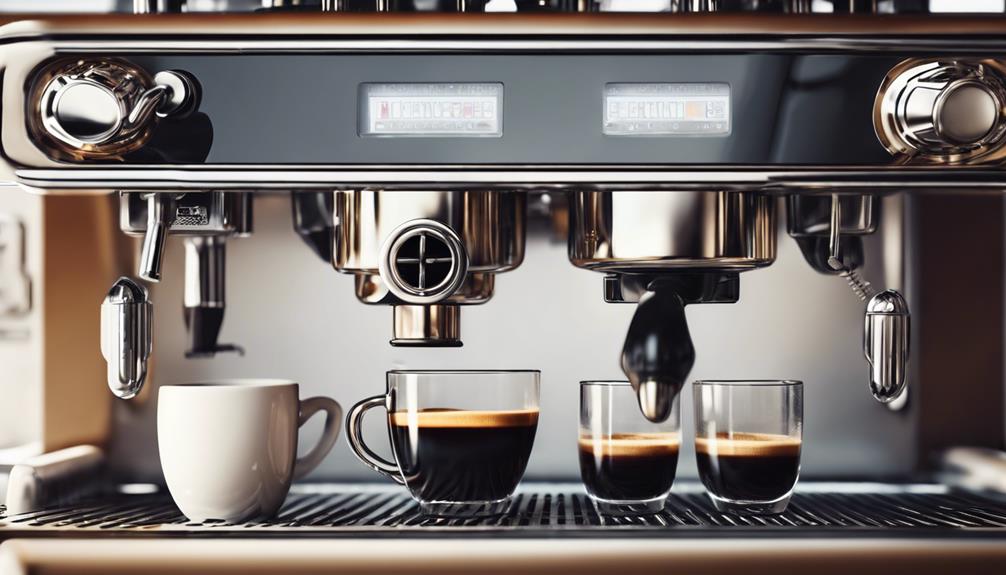
With regular maintenance and replacement of essential espresso parts, you can greatly extend your machine's lifespan and guarantee consistent extraction quality. By prioritizing maintenance, you'll prevent minor issues from becoming major problems, saving you time and money in the long run.
Here are three key ways to enhance your machine's longevity and efficiency:
- Replace essential parts regularly: Group gaskets, shower screens, and other wear-and-tear parts need regular replacement to maintain peak performance.
- Clean your machine thoroughly: After each use, clean the group head and portafilter to prevent coffee residue buildup, ensuring flavor integrity and machine efficiency.
- Use high-quality OEM parts: When replacing parts, opt for OEM components to guarantee compatibility and durability, reducing repair frequency and downtime.
Espresso Machine Maintenance Essentials
You've taken the right steps to enhance your machine's longevity and efficiency, and now it's time to focus on the regular maintenance tasks that'll keep your espresso machine running smoothly. It’s important to regularly descale your machine to prevent mineral buildup and ensure proper water flow. Additionally, keeping the group head and portafilter clean will help maintain the quality of your espresso. And if you ever encounter any issues, don’t hesitate to reach out to a professional for a quick espresso fix. With consistent maintenance, your machine will continue to produce delicious espresso for years to come.
Daily backflushing is essential to remove coffee oils and grounds, guaranteeing peak performance and flavor extraction.
Every three months, replace group gaskets and shower screens to prevent leaks and guarantee consistent water distribution over the coffee grounds. Performing a minor service involves checking group flow rates, temperature consistency, and cleanliness of all machine components.
Additionally, schedule a major service every six months to rebuild the steam assembly and water tap, maintaining frothing capabilities and consistent water flow.
Finally, an annual maintenance check should include a thorough inspection and replacement of key components, such as the pressure safety valve and portafilter baskets, to guarantee the machine operates reliably and efficiently.
Frequently Asked Questions
What Is the Most Important Part of an Espresso Machine?
When you're wondering what makes your espresso machine tick, you're probably thinking, "What's the most important part?" Honestly, it's the group head – it's where the magic happens, directly affecting flavor extraction and ultimately, your coffee's taste and quality.
What Maintenance Do Espresso Machines Need?
You'll need to perform daily, quarterly, and bi-annual maintenance tasks to keep your espresso machine running smoothly, including backflushing, cleaning, and replacing parts to prevent issues and guarantee peak brewing quality.
What Parts of the Espresso Machine Should You Clean Daily and What Parts Should Be Deep Cleaned and How?
You're the master of your espresso machine's cleanliness! Daily, you'll tackle the group head with a machine brush and backflush to remove coffee oils and grounds, while deeper cleaning tasks, like replacing gaskets and shower screens, await you every three months.
Why Is My Espresso Machine Sputtering?
You're wondering why your espresso machine is sputtering? It's likely due to low water levels, blockages in the group head, pump issues, or malfunctioning steam wands – check these common culprits to get your brew back on track!
Conclusion
You've got the know-how to keep your espresso machine humming along!
Remember, regular maintenance and timely replacement of essential parts can make all the difference.
Take the case of Bella's Coffee Shop, which saved $1,000 in repair costs by replacing their worn-out gaskets every 6 months.
By following these essential espresso parts guidelines, you'll be brewing perfect shots and saving cash in no time!
